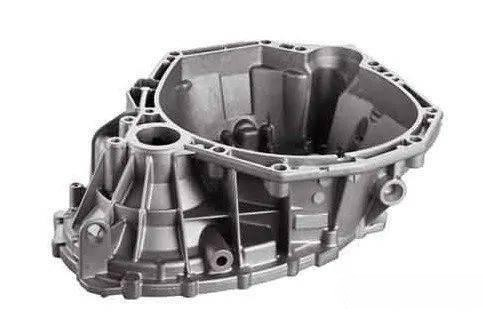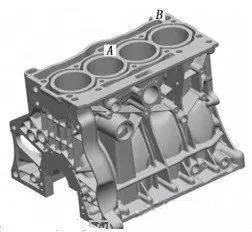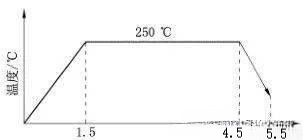Introduction to Aluminum Die Casting Cylinder Block

The following figure shows the Al-9Si-3Cu alloy die-casting cylinder body, with dimensions of 351mm * 334mm * 269mm, wall thickness of (4 ± 0.4) mm, blank mass of 18.9kg, and hardness (HB) of 90-110. The cylinder liner is made of high phosphorus vermicular graphite cast iron, with a hardness (HB) of 220-290 and a wall thickness of 4.4mm. The wall thickness after grinding is 2.8mm. The cylinder structure includes cylinder barrel, water jacket, high-pressure oil passage, crankcase, main bearing seat, etc.

2. Aluminum alloy melting equipment and process
The melting adopts an LPG gas furnace, which has functions of feeding, melting, and insulation. The melting rate is 3.5T/H, and the capacity of the insulation furnace is 10t. To save energy, currently, the aluminum alloy liquid direct delivery process is commonly used, where the aluminum alloy supplier melts the aluminum alloy liquid in the factory and directly delivers the alloy liquid to the insulation furnace in the die-casting workshop.
The alloy grade is Al-9Si-3Cu, and the ratio of aluminum alloy ingot to furnace feed is 4:6; Using a direct reading spectrometer to detect the composition of the alloy liquid before the furnace; The alloy liquid is insulated at 720 ℃ in the insulation room of the melting furnace, and after refining and slag removal in the furnace, it is discharged into the transfer ladle; Using nitrogen (99.99%) and a rotating degassing device for degassing treatment in the transfer ladle can purify the residual gas and residue inside the alloy liquid; Evaluate the degassing effect through a gas content detection device, with a density index of (1- ρ Vacuum/ ρ Normal pressure) * 100, with a control standard of ≤ 1.
3. Design of Die Casting Mold and Pouring System
The mold adopts a six sided core pulling structure, mainly composed of a fixed mold part, a moving mold part, a forming part, a pouring system, a core pulling mechanism, an ejection mechanism, an exhaust system, a heating and insulation device, a positioning and guiding system, etc. The die-casting mold material is 3Cr2W8V and H13 steel, and the core rod can be made of titanium alloy or high-temperature alloy. After heat treatment, its hardness (HRC) reaches 45 or above. After surface nitriding treatment, the lifespan of the die-casting mold can reach over 100000 times.
There are usually two forms of pouring system for cylinder block die-casting: single side pouring system and double side pouring system. Single side pouring system is generally used for small cylinder blocks, while double side pouring system is generally used for large cylinder blocks. By using mold flow analysis software for filling and solidification simulation, the pouring process layout can be optimized.
4. Die Casting Machine and Die Casting Process
In order to obtain high-quality die castings, key process parameters such as temperature, speed, pressure, and time must meet the needs of die casting production.
(1). Temperature control
The pouring temperature should be controlled between 640-680 ℃. If the pouring temperature is too high, the shrinkage is large, and the casting is prone to cracks, coarse grains, and mold sticking; If the pouring temperature is too low, it is easy to produce defects such as cold shuts, surface patterns, and insufficient pouring. During pouring, it should be ensured that the surface oxidation layer of the aluminum alloy liquid in the insulation furnace is cleaned in a timely manner, otherwise it may lead to oxidation inclusion defects.
Die casting molds should be preheated to a certain temperature before use. In continuous production, the temperature of the die-casting mold often increases. Excessive temperature not only causes the liquid metal to stick to the mold, but also causes slow cooling of the casting, resulting in coarse grains and deformation during ejection.
Six mold temperature heaters are used for heating the aluminum alloy cylinder block mold, and cooling water is used for all cores, inserts, etc. to control the working temperature of the mold within the range of 180-200 ℃.
(2). Speed and pressure control
The quality of cylinder block die-casting is very sensitive to changes in injection process parameters.
Excessive speed can easily cause an increase in gas in the casting; If it is too low, it can easily cause poor filling.
If the injection pressure is too low, defects such as porosity and shrinkage in the casting increase; Excessive pressure increases defects such as flash and burrs, which can also cause significant damage to the mold.
Take appropriate injection speed (injection specific pressure), determine a reasonable speed conversion position, and achieve rapid pressurization of the casting before solidification (pressurization specific pressure).
Due to the large size, complex structure, and significant wall thickness differences of the cylinder body, a 28000kN die-casting machine was used, with a slow injection speed of about 0.2m/s, a slow injection stroke of 400mm, and a fast injection speed of about 5.5m/s. The final pressure was maintained at around 45MPa.
(3). Time control
The length of filling time depends on the size and complexity of the casting volume. The filling time is closely related to the cross-sectional area of the inner gate and is directly related to the injection speed of the punch. The filling time is ultimately reflected in the second level injection velocity, which means the fast injection velocity is controlled at 4-5m/s.
After filling the mold cavity with alloy liquid, it will enter the solidification forming stage. At this time, immediate pressurization should be carried out to solidify and crystallize the alloy liquid under high pressure. The pressure building time of large tonnage die-casting machines should be controlled within 30ms, and small die-casting machines can reach 10ms.
The length of holding time depends on the material and wall thickness of the casting. If the holding time is too short, it is easy to produce pores and shrinkage porosity; If the holding time is too long, the temperature of the casting will be low, the shrinkage will be large, and the resistance during core pulling and ejection of the casting will be large. This not only makes it difficult to mold out, but also easily causes cracking of the casting, usually taking 30 seconds.
(4). Implementation of Automatic Production Unit for Die Casting
The die-casting machine is equipped with peripheral auxiliary devices such as a pouring robot, a spraying robot, a piece picking robot, and a cutting machine, which can achieve fully automatic production with a single piece speed of 110s.
① Alloy liquid insulation
Transfer the alloy liquid with qualified composition and gas content to the insulation furnace in front of the die-casting machine for insulation through the transfer ladle, and control the temperature between 640-680 ℃.
② Cast iron cylinder liner insertion
Before the cylinder liner is embedded, it needs to be preheated to 90 ℃ to avoid cracking caused by aluminum alloy shrinkage stress.
③ Cleaning of the pouring system
Using an automatic hydraulic edge cutting machine and edge cutting mold, cutting the pouring system, overflow system, and flash inside the cylinder hole.
(5). Heat treatment
The residual stress in cylinder block casting includes thermal stress, phase transformation stress, and shrinkage stress. Residual stress reduces the mechanical properties of castings and affects their machining accuracy. By natural aging for 24 hours and T5 treatment, residual stress can be eliminated.
The following figure shows the T5 processing curve.

T5 treatment will result in a decrease of 8-10 in the hardness (HB) of the casting. By increasing the content of Cu, Si, Mn, and appropriately reducing the temperature of T5 treatment, ideal casting hardness can be obtained. Among them, the increase in Cu content has a significant effect on increasing hardness, but the material cost is relatively high. Orthogonal tests of chemical composition and temperature are needed to determine the process plan.
The hardness measurement points are shown in points A and B in Figure 1.
(6). Rough machining
To ensure that the delivered products meet the subsequent precision machining positioning and processing accuracy, rough machining of the blank is necessary to eliminate casting tolerances. The rough machining range includes positioning hole, main bearing seat, cylinder hole, etc., all of which are completed by machining center.
(7). Leak testing
The parts after rough machining need to undergo leak testing, which is divided into water jacket leak testing, high-pressure oil passage, and low-pressure oil chamber. The leakage testing process is mainly divided into four stages: inflation, pressure stabilization, measurement, and exhaust.
(8). Infiltration
For leaking parts that require a water jacket leakage of less than 100mL and a crankcase leakage of less than 500mL, infiltration treatment will be carried out to fill the fine pores and shrinkage porosity of the casting with organic infiltration liquid, so that the cylinder body meets the required airtightness requirements. For blank leakage, infiltration is only for repairing parts with surface shrinkage and cold shut defects, and its proportion is very small. After machining, the thick wall shrinkage areas of the blank can only be exposed, and the infiltration of the finished product is an important repair process.
ZheJiang Dongrun Casting Industry Co,.Ltd was built in 1995, We have been in the casting industry for more than 25 years. No matter what type of molding you need done, we are the right supplier for your jobs. Unlike other of our competition, we offer four types of castings.
Dongrun Casting have 20000 square meters facility houses and 200 production & test equipment, From quotation and tooling design to casting and finished machining, we can work with you at every stage. We serves wide range of industries-from Fortune 500 corporations to small and midsize OEMs. Our products includes:
❖ HVAC | ❖ Architectural parts |
Browse our online showroom to see what we can do for you. And then E-mail:dongrun@dongruncasting.com us your specifications or inquiries today
